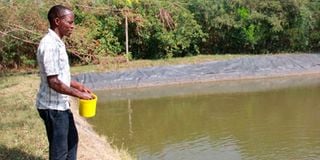My 1,000 fish thrive on calliandra

Maxwell Ochoo feeding his fish with calliandra leaves at his farm in Homa Bay.
What you need to know:
- Fish farmer has planted 1,000 calliandra trees, whose foliage he uses as supplemental fish feeds.
- He has planted 1,000 calliandra trees, whose foliage he uses as supplemental fish feeds.
When he dug up a pond on his farm in Lambwe East in Homa Bay County in May 2019, Maxwell Ochoo wanted to cash in as fish stocks dwindle in Lake Victoria.
Today, Ochoo, 33, is on the way of accomplishing the mission as he is one of the few fish farmers in Lambwe, a dry region in Mbita sub county, engaging in aquaculture.
One of the things that stand out on Ochoo’s fish farm is that he has found a way of cutting costs.
He has planted 1,000 calliandra trees, whose foliage he uses as supplemental fish feeds.
Seeds of Gold team finds him mixing fish pellets and calliandra leaves before feeding the fish at 10am.
“I learnt about fish production in 2018 in a one-week training done by a non-governmental organisation,” says Ochoo, who is a member of Regreening Lambwe Initiative, a group that consists of 14 people all who keep fish .
In the training, they learnt about fish farming and ever green agricultural practices.
Production costs
Besides sharing ideas on fish production, the members also help each other establish ponds.
Members of the group helped Ochoo dig up his pond that measures 17 by 20 metres, enabling him to save Sh30,000 used for such work.
After digging his pond, he waited for surface runoff from surrounding hills to fill it.
Ochoo, who also grows fruits and horticultural produce, first stocked some 1,000 fingerlings in his pond in August 2019 that cost him Sh5,000. He then found the cost of feeds too high.
Depending on the protein content, fish pellets cost between Sh2,500 and Sh5,000 per 50 kilos per sack.
“I did my production costs and realised that I would spend at least Sh30,000 on feeds for the eight months the fish were to mature,” says Ochoo, who started offering his fish sukuma wiki to cut costs.
But this was not sustainable and the fish were not eating the feeds well. He switched to protein-calliandra that he had planted.

Maxwell Ochoo dries calliandra leaves before feeding his fish on his farm in Homa Bay.
To feed the fish calliandra, one harvests the leaves which are then dried in the sun.
"Drying helps to separate the leaves from the main stalk that is not beneficial to fish. It also pollutes the pond," Ochoo says.
After drying, he rubs the fodder with his two palms to separate the leaves from the main stalks.
He then mixes half a kilo of fish pellets with a kilo of calliandra leaves and feeds the fish in the morning. The same quantity is given to fish in the evening.
Ochoo says since he began using calliandra, his cost of production has declined.
"Initially, the fish would consume 2kg of feeds every day. Today, however, I use the same quantity for two days.”
Homa Bay County Aquaculture Business Development programme officer Michael Omondi notes calliandra leaves have good protein content.
Nutritional content
“It is like eating fruits after eating ugali. The leaves give the fish its bright colour. Some manufactured fish pellets do have all nutrients therefore supplemental fish feeds are recommended,” he says.
Feeding his fish calliandra has not affected their growth, he says, noting they mature in eight months.
"I harvested my first stock after eight months unlike some of my colleagues who did after a year. Since calliandra contains proteins, they gain weight faster,” says Ochoo, who adds he earned over Sh250,000 from his over 1,000 fish.
He expects more as he has fully embraced calliandra, says the farmer, who quit his job to be a fulltime farmer. Until recently, his main challenge was theft of fish but he moved onto the farm where he now lives.
However, Safina Musa, a research scientist at Kenya Marine Research Institute notes fish pellets should be cautiously mixed with foreign feeds because they have all the nutritional content and provide a complete diet.
She adds that some foreign feeds pollute ponds.
“Some supplemental feeds make fish use a lot of energy when feeding. The energy could be spent in growth,” the researcher says.





